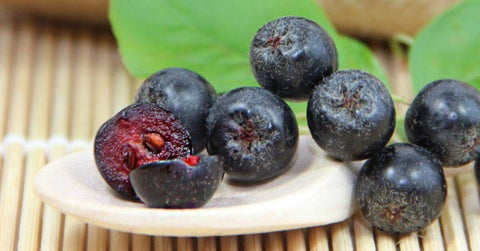Just exactly how many cells are there inside the human body? The number is almost too large to even imagine. Our body consists of approximately 70 trillion building blocks, which we summarize under the term “body cells”. 70 trillion, that’s a seven with 13 zeros! If you were to line up all of the microscopic human cells, it would span the circumference of the Earth about 50 times. So how can you optimally protect and support your body’s cells, and what role do Aronia berries play? Read it in today’s blog post to find out.
Our cells not only hold the body together like microscopic building blocks, but they are also the key to our health and well-being. They should therefore be cared for and benevolently supplied. As with any good partnership, the relationship between us and our cells is based on a balance of giving and receiving. If we take care of our cells with everything they need, they will in turn thank us with routine metabolic processes and keeping us healthy. In addition to the metabolic processes that take place in our body, around 10 billion cells in our body are renewed every day. After about 90 to 120 days of cell renewal, we can theoretically speak of ourselves as a new person.
Optimal Care for Cells

Everyone can help to ensure that their cells are optimally supplied. But how can you properly support your cells, whether they be skin, liver, or vascular cells? There are three simple rules to follow:
∙ Eat a diet rich in vitamins and minerals, taking in a high amount of phytochemicals and antioxidants – for example, fresh fruit and vegetables.
∙ Drink plenty of good water. An optimal amount of water for healthy adults is around 30ml per kilogram of body weight. (For a woman with a bodyweight of 65kg, this would correspond to roughly 1.9 litres; a man with a bodyweight of 80kg should then drink 2.6 litres throughout the day.)
∙ Use high-quality, cold-pressed oils containing Omega 3s as well as DHA and EPA, such as domestic linseed oil.
By following these three simple rules, you will significantly support your cells. This allows the cells to take care of their metabolism unhindered, while at the same time rendering free radicals harmless.
Free Radicals damage the Cells

Free radicals are a byproduct created during metabolism. They occur naturally in the body and can be broken down by the body. However, if there is an excess of free radicals, they can cause damage.
Certain substances can also promote the increase of free radicals, including:
∙ toxins from chemical sprays and fertilizers in our food
∙ the consumption of drugs, such as alcohol or nicotine
∙ regular medication
Excessive UV radiation, radiation from mobile radio stations, and increasing air pollution are also suspected of contributing to the fact that free radicals are increasingly detectable in our bodies.
“Oxidative stress”, that is an overweight of free radicals in the body, contributes significantly to cell ageing and damage. It is the cause of skin ageing and diseases such as cancer.
Antioxidants – edible Cell Protection
Antioxidants can protect the body’s cells by intercepting free radicals and rendering them harmless – they are also called “radical scavengers”. The great thing about them, though? You can eat them. With the right choice of food and drinks, everyone can ensure that their 70 billion body cells are optimally protected against free radicals.

There are around 20,000 bioactive botanicals that determine the color and taste of fruits or vegetables, and some offer us antioxidants. For example, some plant varieties with bitter-tasting fruits protect themselves from voracious pests, and other brightly colored fruits attract birds and insects, which ensure their spread. These bioactive plant substances include plant dyes such as carotenoids or anthocyanins.
Natural plant dyes, which are consumed every day, guarantee an optimal supply of valuable radical scavengers.
The rule of thumb: the more intense the color, the higher the antioxidative power of the food.
Particularly dark dyes, like anthocyanins, should be a daily part of the menu. Vegetables such as beetroot and red cabbage, which are known to have very high colour intensity, provide more antioxidants than cucumbers, for example. The same applies to fruits.
Aronia as Cell Protection
Aronia berries are the absolute leaders among fruit and berry varieties here. Even when mixed with water, the juice of the Aronia berries remains deep red – so it has an unusually high colour intensity.
Aronia berries have a high potential as radical scavengers and are easy to include in your diet. Whether as a high-quality juice, Aronia powder, or as dried berries, how you consume Aronia berries is up to you. In any case, you are doing yourself, and your cells, something good.

Here is a short list of the most common forms of processed Aronia berries and how you can eat them:
∙ Aronia juice: 100 ml daily. Enjoy the tart juice pure or diluted with water.
∙ Aronia powder: 1-2 tbsp daily. Refine muesli, quark or yogurt dishes with the colour-intensive Aronia powder.
∙ Dried berries: 1-2 tablespoons daily. Dried Aronia berries are suitable for mueslis or as an addition to fruity desserts. If dried Aronia berries seem too hard for you, it helps to soak them in a little bit of juice (Aronia juice is ideal) overnight.
Aronia powder and dried berries are also an excellent addition for cooking or baking since the ingredients are heat-stable up to 180 °C.
Conclusion
Every cell within the body is important so that the miracle of the human being can function optimally and healthily. In return for this daily work, each of us can contribute to the optimal condition of our cells.



